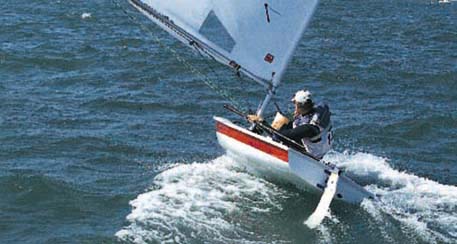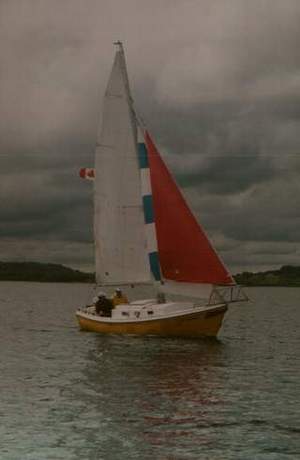|
Downwind Sailing Technique
by Ed Adams
______________________________________________________________________
Ever wondered how to create a passing lane for yourself downwind? Read on to
find out how to.......Zig Zag your way from top to the bottom.
Sailing more distance can get you there faster. Olympian Nick Adamson
demonstrates the newest way to get downhill.
I've been skiing for as long as I've been sailing. But I didn't see the
connection between the two sports until I stepped back into a Laser after a
15-year hiatus. Now I realize that powerful turns are required in both sports,
and that a good turn often begins with a near-spill. In skiing, this tight-wire
defiance of gravity is done to ride the mountain; in sailing it's done to ride
waves.
The Laser regatta that opened my eyes began in a moderate sea breeze. I
rounded the first mark in good shape, just ahead of a tight pack of five boats.
The next leg was a broad reach on starboard, so being a seasoned, mature sailor,
I stayed high after the rounding to protect my clear air on the long jibe.
The gangly teenager who rounded a few boats behind had a different idea. He
immediately rolled into a jibe and took off on port at a hot angle, reaching
away from the rhumbline. That's the last we'll see of him, I thought. Wrong!
The rest of our pack lined up on starboard, in nice, neat tactical formation.
After reaching out of our peripheral vision, the kid then bore off sharply,
sailing 30 degrees by the lee, "railed-up" in near-capsize. Riding the
knife edge, he surfed a wave directly back through everyone's dirty air,
crossing inches in front of the pack. Oblivious to his gains and his new
weathermost position, he carved a radical 60-degree turn up to reach away from
us again, searching for yet another wave.
This radical zigzagging continued the whole leg. He never jibed. He never
looked back. He never pointed at the mark. He didn't care about clear air or the
old folks astern. And by the leeward mark, he was 100 yards ahead of everyone. I
felt like Rip Van Winkle.
Since that Laser regatta, I've been fortunate to have the opportunity to
coach Nick Adamson, who won the U.S. Olympic Trials with downwind abilities that
far exceed those of the gangly teenager. Before we look at his advanced skills,
let's examine some of the basic skills first.
Basic skills - The first skill you need to master is sailing by the lee. To
find out why, take a look at the illustration on the opposite page. But realize
that mainsheet trim by the lee varies with the wind strength. In light air, it
pays to ease the boom well past perpendicular. As the wind builds, the sheet
should be eased less and less, and trimmed well aft of perpendicular in heavy
air (over 15 knots). Over easing the sheet in more wind will often cause a
capsize.
The second skill to master is knowing when to make wave riding the priority.
In light air, or when the wind is offshore, waves travel slowly. You should
ignore them and sail straight at the mark.
As the wind speed or fetch increases, so does the speed of the waves. In most
moderate, onshore breeze conditions the waves will be traveling faster than your
flat water boat speed. Then it will pay to zigzag, hunting, catching and riding
waves. Don't hunt unless you see something worth catching.
Once the wind builds to the point where you are planing all the time, your
speed can exceed that of the waves. Then your goal is to sail toward the mark as
directly as possible, avoiding the steepest waves.
When hunting for waves to ride in moderate air, speed makes the job easier.
By reaching up as a wave approaches, you build the speed required to jump onto
the wave face. When the wave lifts your transom, bear off to grab the ride.
Don't sail directly down the wave. If you can sail across the wave face like a
surfer, you can attain higher speeds while still making the same progress dead
downwind, toward the mark. That extra speed comes in handy when it's time to
turn off that wave and hunt for your next ride.
In a boat with an unstayed rig, you can sail across the wave face two ways:
on a reach or by the lee, as there are no shrouds to restrict how far you can
ease the mainsheet. This two-directional ability gives you twice as much
territory in which to hunt waves. The turn down to by the lee is called a top
turn, because it is done at the top of a wave, as it lifts your transom. The
turn up is called a bottom turn, because it is usually done just before you
reach the trough of the wave you are riding.
Tactical position - While most gangly teenagers are, by nature,
tactically oblivious, there are some strategic principles involved in going fast
while zigzagging. First, consider the wind strength. If it is out-of-control
windy, approach the run as you would in a keelboat: get on the long jibe that
takes you on a broad reach toward the leeward mark. Reaching provides you a
wider choice of angles to avoid slow-moving waves. Sailing by the lee is too
angle-critical; you're likely to plow into a wave and capsize.
However, in any other wind strength, do the opposite of what the sailing
books say: Get on the lifted jibe. If you come into the weather mark in a
left-hand shift, jibe onto port so you can be by the lee immediately, while
pointing most directly at the mark. If you're not sure which shift you're on,
don't worry about it - you'll go just about as fast whether you reach or sail by
the lee. Pressure and waves are far more important.
Clear air does matter, as better pressure always means better speed. But
lateral freedom is just as important. In wave-riding conditions, you need to
have at least 100 feet of space on either side of you, so your bottom and top
turns can be made without restriction from other boats. So pick a course that
gets you away from the crowd early.
Finally, get out on the water and put in your practice time. Wave riding is a
high-wire act. Like skiing, the only way to negotiate a mogul field is with
perfect, fearless balance - with confidence born of many hours and countless
capsizes.
Ed Adams is a past Laser national champion, and US Sailing Team coach.
The Dynamics of Sailing By the Lee
A loose vang allows the leech to pump
automatically in chop. Every little pump propels the boat. It also throws a
pressure vortex off the leech that circulates downwind and is recaptured as the
boat sails across the wind.
The leech provides a clean leading edge
for attachment of leech-to-luff airflow at shallow angles past dead downwind.
Watch the telltales.
Heeling to weather raises the center of
effort into stronger wind aloft. It also positions the effort over the boat for
a more balanced helm, which reduces rudder drag.
In light air, easing the boom past
perpendicular boosts sheet pressure and feedback, as mechanical advantage is
decreased. It also lays the sail forward when heeled to weather, so gravity
works to keep the sail pressurized.
Wetted surface is reduced when heeled to
weather.
Photo
credit: Daniel Forster.
|

